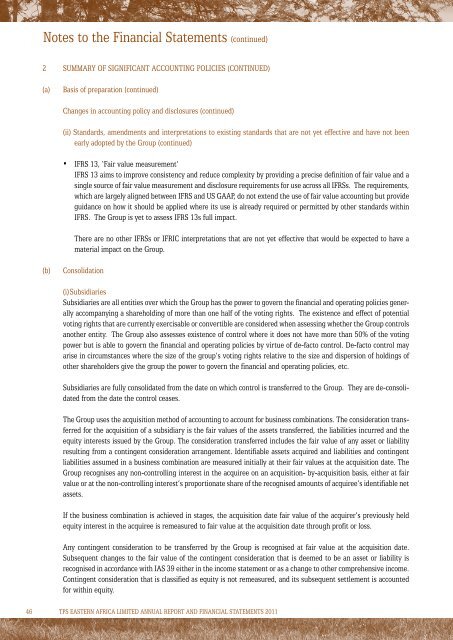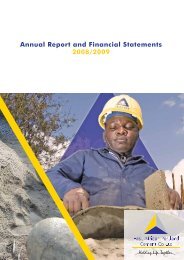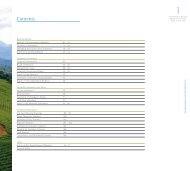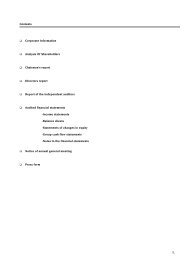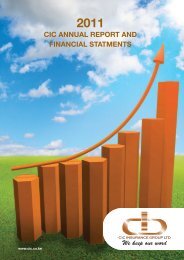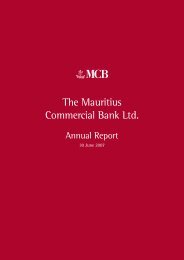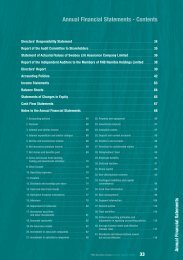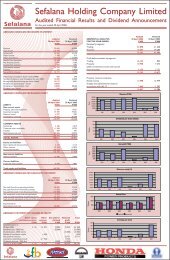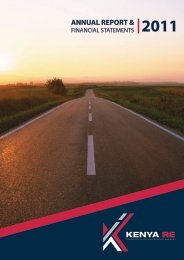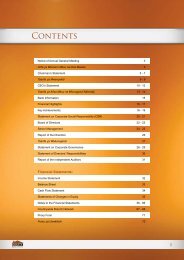2011 Annual Report and Accounts - Investing In Africa
2011 Annual Report and Accounts - Investing In Africa
2011 Annual Report and Accounts - Investing In Africa
Create successful ePaper yourself
Turn your PDF publications into a flip-book with our unique Google optimized e-Paper software.
Notes to the Financial Statements (continued)<br />
2 Summary of significant accounting policies (continued)<br />
(a)<br />
Basis of preparation (continued)<br />
Changes in accounting policy <strong>and</strong> disclosures (continued)<br />
(ii) St<strong>and</strong>ards, amendments <strong>and</strong> interpretations to existing st<strong>and</strong>ards that are not yet effective <strong>and</strong> have not been<br />
early adopted by the Group (continued)<br />
• IFRS 13, ‘Fair value measurement’<br />
IFRS 13 aims to improve consistency <strong>and</strong> reduce complexity by providing a precise definition of fair value <strong>and</strong> a<br />
single source of fair value measurement <strong>and</strong> disclosure requirements for use across all IFRSs. The requirements,<br />
which are largely aligned between IFRS <strong>and</strong> US GAAP, do not extend the use of fair value accounting but provide<br />
guidance on how it should be applied where its use is already required or permitted by other st<strong>and</strong>ards within<br />
IFRS. The Group is yet to assess IFRS 13s full impact.<br />
There are no other IFRSs or IFRIC interpretations that are not yet effective that would be expected to have a<br />
material impact on the Group.<br />
(b)<br />
Consolidation<br />
(i) Subsidiaries<br />
Subsidiaries are all entities over which the Group has the power to govern the financial <strong>and</strong> operating policies generally<br />
accompanying a shareholding of more than one half of the voting rights. The existence <strong>and</strong> effect of potential<br />
voting rights that are currently exercisable or convertible are considered when assessing whether the Group controls<br />
another entity. The Group also assesses existence of control where it does not have more than 50% of the voting<br />
power but is able to govern the financial <strong>and</strong> operating policies by virtue of de-facto control. De-facto control may<br />
arise in circumstances where the size of the group’s voting rights relative to the size <strong>and</strong> dispersion of holdings of<br />
other shareholders give the group the power to govern the financial <strong>and</strong> operating policies, etc.<br />
Subsidiaries are fully consolidated from the date on which control is transferred to the Group. They are de-consolidated<br />
from the date the control ceases.<br />
The Group uses the acquisition method of accounting to account for business combinations. The consideration transferred<br />
for the acquisition of a subsidiary is the fair values of the assets transferred, the liabilities incurred <strong>and</strong> the<br />
equity interests issued by the Group. The consideration transferred includes the fair value of any asset or liability<br />
resulting from a contingent consideration arrangement. Identifiable assets acquired <strong>and</strong> liabilities <strong>and</strong> contingent<br />
liabilities assumed in a business combination are measured initially at their fair values at the acquisition date. The<br />
Group recognises any non-controlling interest in the acquiree on an acquisition- by-acquisition basis, either at fair<br />
value or at the non-controlling interest’s proportionate share of the recognised amounts of acquiree’s identifiable net<br />
assets.<br />
If the business combination is achieved in stages, the acquisition date fair value of the acquirer’s previously held<br />
equity interest in the acquiree is remeasured to fair value at the acquisition date through profit or loss.<br />
Any contingent consideration to be transferred by the Group is recognised at fair value at the acquisition date.<br />
Subsequent changes to the fair value of the contingent consideration that is deemed to be an asset or liability is<br />
recognised in accordance with IAS 39 either in the income statement or as a change to other comprehensive income.<br />
Contingent consideration that is classified as equity is not remeasured, <strong>and</strong> its subsequent settlement is accounted<br />
for within equity.<br />
46 TPS EASTERN AFRICA LIMITED ANNUAL REPORT AND FINANCIAL STATEMENTS <strong>2011</strong>


